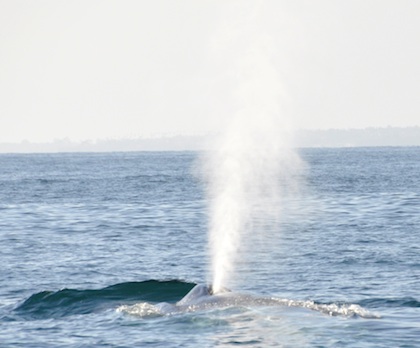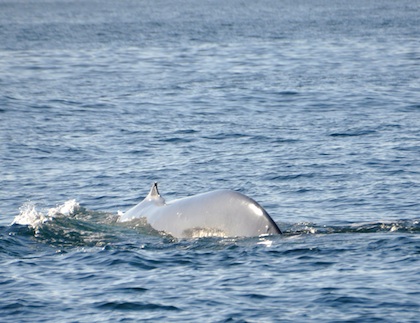Blue Whale Watching With Dana Wharf Tours
The 2004 Indonesia earthquake and tsunami brought the blue whales to Southern California. At least that is the current theory those studying the blue whales that summer off the Orange County coast seem to be focusing on. The earthquake altered ocean currents, resulting in a surge of krill in the coastal waters off Southern California. Blue whales happen to be huge fans of krill, consuming a half million calories worth of the little critters in a single mouthful. So where the krill goes, they go. We think…
One thing is for certain, the chances of seeing a blue whale off the coast of Orange County was slim to none ten years ago. These days, your odds are pretty fantastic. Last year, the blue whales lingered well into the fall, resulting in almost 800 sightings by Dana Wharf Whale Watching passengers. This year, the whales showed up a bit later than last, with the first blue whales being spotted in mid-June and expected to linger into the fall.
 Blue whales are the largest animals on the entire planet. They measure approximately 100 feet in length, have a heart the size of a Honda Civic, and a major artery so big that a small child could climb inside of it! At one time, there were around 200,000 blue whales swimming in our Earth's oceans but due to the extensive whaling of the 1800's, there number dwindled down below 2000. Luckily, thanks to the protection of these whales by countries such as the United States, there are now around 12,000 blue whales worldwide, yet less than 1% of the population will ever catch a glimpse of these gentle giants.
Blue whales are the largest animals on the entire planet. They measure approximately 100 feet in length, have a heart the size of a Honda Civic, and a major artery so big that a small child could climb inside of it! At one time, there were around 200,000 blue whales swimming in our Earth's oceans but due to the extensive whaling of the 1800's, there number dwindled down below 2000. Luckily, thanks to the protection of these whales by countries such as the United States, there are now around 12,000 blue whales worldwide, yet less than 1% of the population will ever catch a glimpse of these gentle giants.
 My family tried our luck just a few days after that initial sighting in June and were thrilled to spot not one, but three different blue whales during our two hour cruise up the Laguna coastline. It was a typical Southern California afternoon filled with sunshine and blue skies and on our ride out to where the blue whales were known to be feeding the captain shared his knowledge of the whales and other animals that call these waters home. As soon as the first spray of a blue whale was spotted by passengers excited fingers pointed in its direction as children let out squeals of pure delight. The whale hung out at the surface for a few precious minutes before flipping its massive tail up to the sky and diving down deep to feed.
My family tried our luck just a few days after that initial sighting in June and were thrilled to spot not one, but three different blue whales during our two hour cruise up the Laguna coastline. It was a typical Southern California afternoon filled with sunshine and blue skies and on our ride out to where the blue whales were known to be feeding the captain shared his knowledge of the whales and other animals that call these waters home. As soon as the first spray of a blue whale was spotted by passengers excited fingers pointed in its direction as children let out squeals of pure delight. The whale hung out at the surface for a few precious minutes before flipping its massive tail up to the sky and diving down deep to feed.
 Blue whales tend to feed like clockwork, diving down deep for about 8-10 minutes before returning to the surface for a breath, exhaling with a telltale spout into the air. When whale watching, those 8-10 minutes seem to move like molasses because every onboard just can't wait to catch another glimpse of the massive creature. There is just something so special about witnessing the largest animal to ever live on Earth going about its day.
Blue whales tend to feed like clockwork, diving down deep for about 8-10 minutes before returning to the surface for a breath, exhaling with a telltale spout into the air. When whale watching, those 8-10 minutes seem to move like molasses because every onboard just can't wait to catch another glimpse of the massive creature. There is just something so special about witnessing the largest animal to ever live on Earth going about its day.
Beyond blue whales, passengers can expect to see dozens of common and bottlenose dolphins which love to play in the boat's wake. They will also see sea lions lazily lying on top of buoys and may even catch a glimpse of a minke, humpback, or fin whale- the second largest animal on Earth. Are you ready to see whales for yourself and looking for a bargain? Be sure to come on Tuesdays when tickets are always half price.
Half Price Tuesdays & Kids Fishing Clinic at Dana Wharf
Sharlene Earnshaw is the editor for Trekaroo, a website dedicated to helping families travel better.




